Intercultural Management: Culture and Motivation - A Literature Review
VerifiedAdded on 2023/06/12
|7
|1771
|466
Literature Review
AI Summary
This literature review delves into the concept of intercultural management, emphasizing the importance of understanding and respecting diverse cultures in international business contexts. It highlights how culture shapes employee motivation, drawing upon Hofstede's Cultural Dimensions Theory to illustrate differences in cultural values and their impact on workplace dynamics. The review also examines various strategies that organizations can implement to effectively manage cross-cultural situations, including conducting research, building relationships, utilizing communication technology, and addressing conflicts. Ultimately, the report underscores the significance of cross-cultural understanding for fostering positive work environments, enhancing employee motivation, and ensuring long-term organizational success in a globalized world. Desklib provides access to similar solved assignments and resources for students.
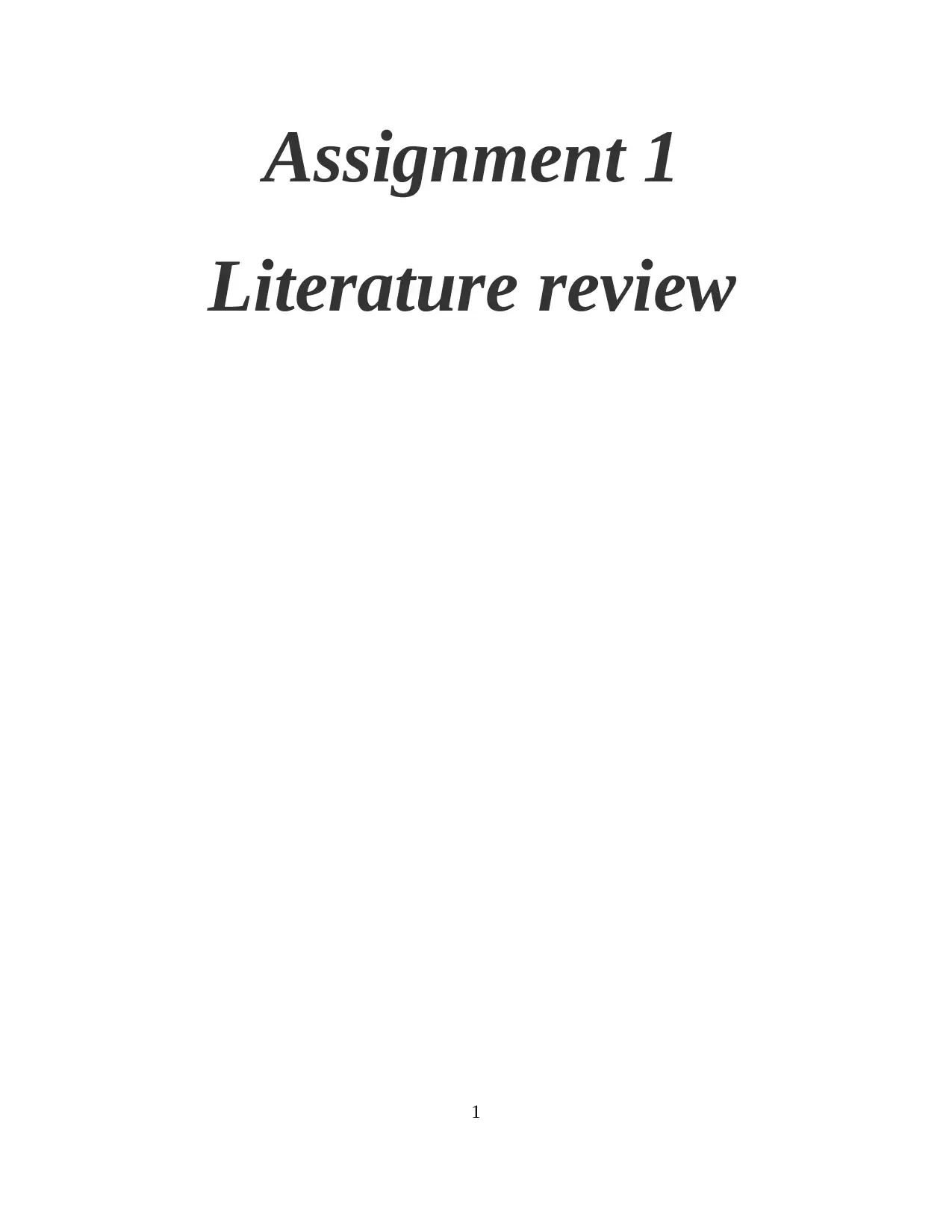
Assignment 1
Literature review
1
Literature review
1
Paraphrase This Document
Need a fresh take? Get an instant paraphrase of this document with our AI Paraphraser
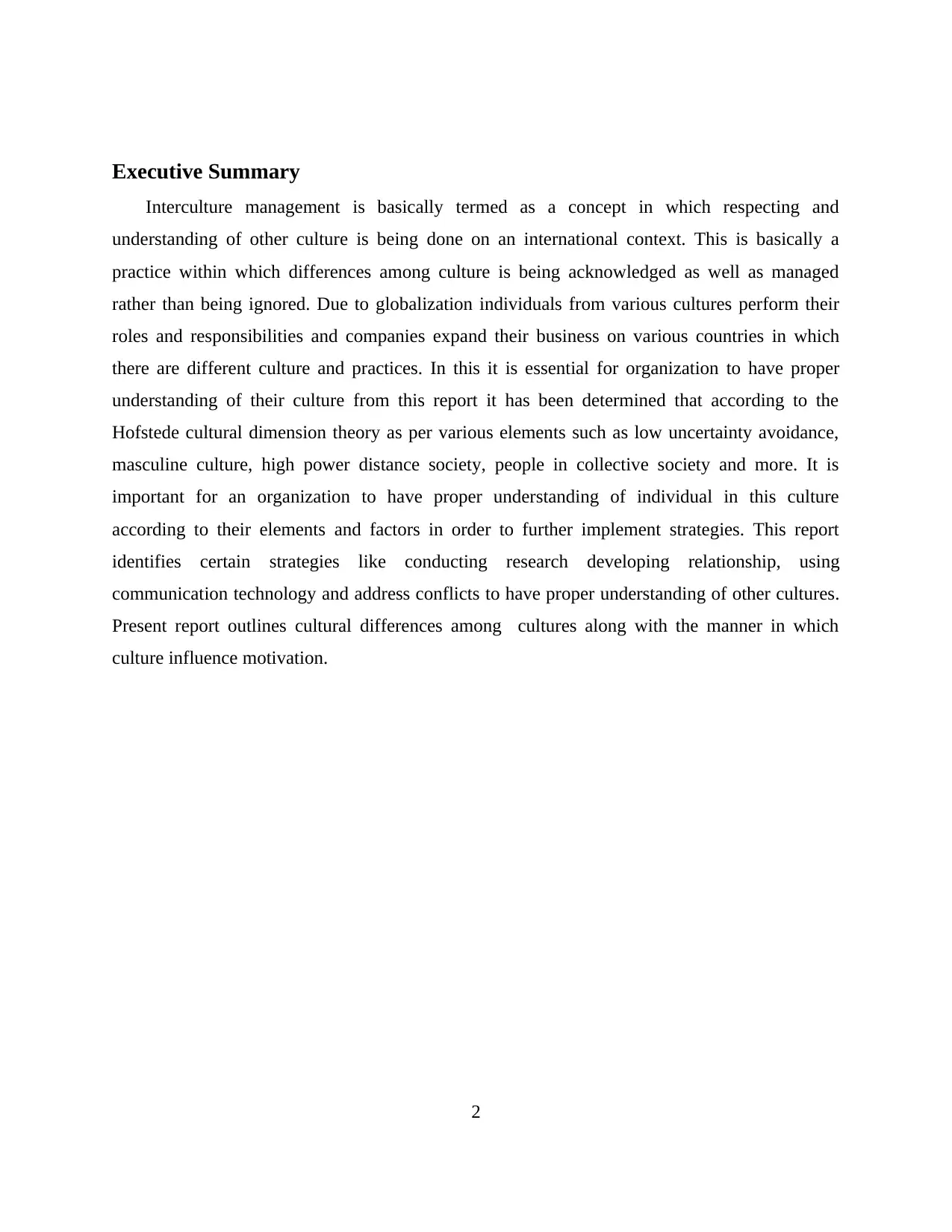
Executive Summary
Interculture management is basically termed as a concept in which respecting and
understanding of other culture is being done on an international context. This is basically a
practice within which differences among culture is being acknowledged as well as managed
rather than being ignored. Due to globalization individuals from various cultures perform their
roles and responsibilities and companies expand their business on various countries in which
there are different culture and practices. In this it is essential for organization to have proper
understanding of their culture from this report it has been determined that according to the
Hofstede cultural dimension theory as per various elements such as low uncertainty avoidance,
masculine culture, high power distance society, people in collective society and more. It is
important for an organization to have proper understanding of individual in this culture
according to their elements and factors in order to further implement strategies. This report
identifies certain strategies like conducting research developing relationship, using
communication technology and address conflicts to have proper understanding of other cultures.
Present report outlines cultural differences among cultures along with the manner in which
culture influence motivation.
2
Interculture management is basically termed as a concept in which respecting and
understanding of other culture is being done on an international context. This is basically a
practice within which differences among culture is being acknowledged as well as managed
rather than being ignored. Due to globalization individuals from various cultures perform their
roles and responsibilities and companies expand their business on various countries in which
there are different culture and practices. In this it is essential for organization to have proper
understanding of their culture from this report it has been determined that according to the
Hofstede cultural dimension theory as per various elements such as low uncertainty avoidance,
masculine culture, high power distance society, people in collective society and more. It is
important for an organization to have proper understanding of individual in this culture
according to their elements and factors in order to further implement strategies. This report
identifies certain strategies like conducting research developing relationship, using
communication technology and address conflicts to have proper understanding of other cultures.
Present report outlines cultural differences among cultures along with the manner in which
culture influence motivation.
2
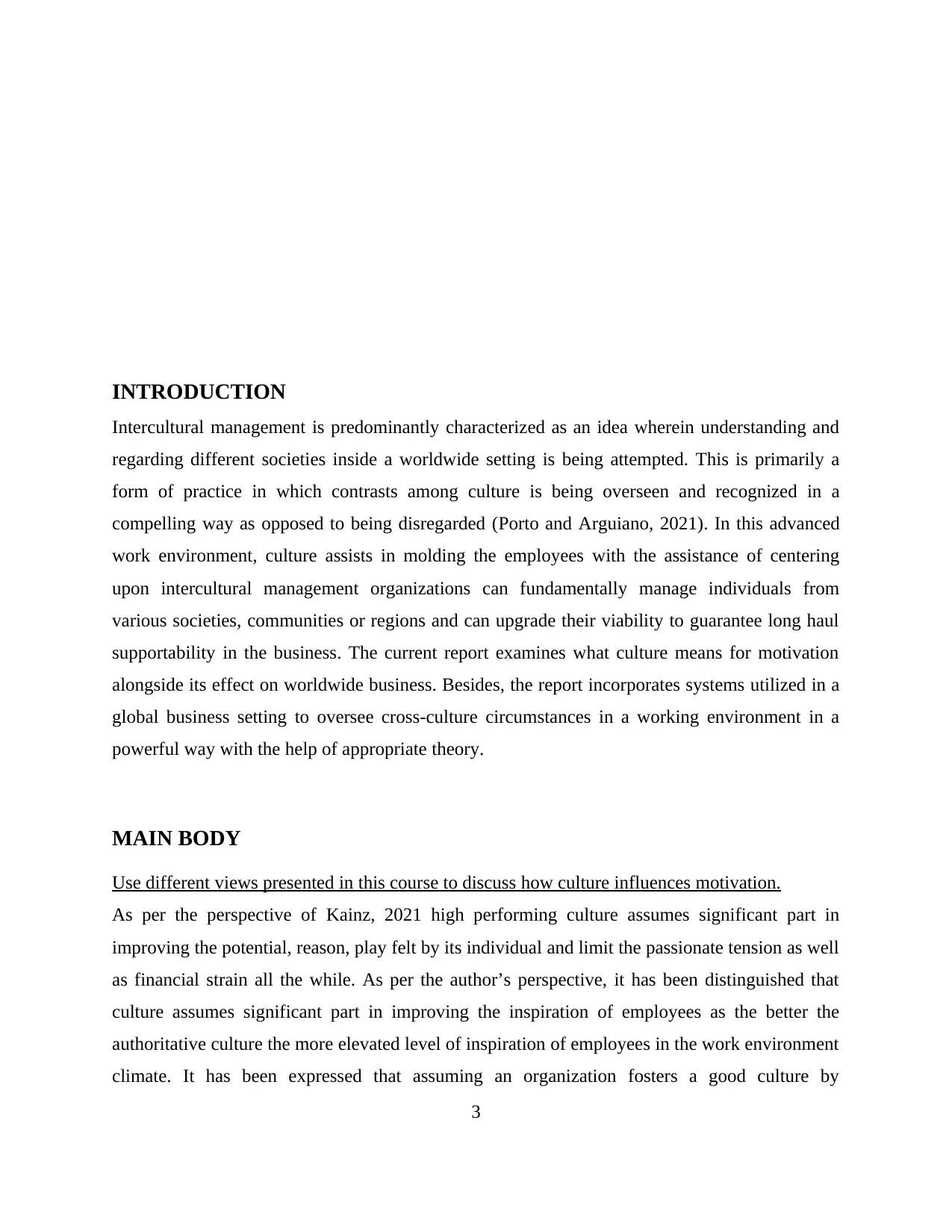
INTRODUCTION
Intercultural management is predominantly characterized as an idea wherein understanding and
regarding different societies inside a worldwide setting is being attempted. This is primarily a
form of practice in which contrasts among culture is being overseen and recognized in a
compelling way as opposed to being disregarded (Porto and Arguiano, 2021). In this advanced
work environment, culture assists in molding the employees with the assistance of centering
upon intercultural management organizations can fundamentally manage individuals from
various societies, communities or regions and can upgrade their viability to guarantee long haul
supportability in the business. The current report examines what culture means for motivation
alongside its effect on worldwide business. Besides, the report incorporates systems utilized in a
global business setting to oversee cross-culture circumstances in a working environment in a
powerful way with the help of appropriate theory.
MAIN BODY
Use different views presented in this course to discuss how culture influences motivation.
As per the perspective of Kainz, 2021 high performing culture assumes significant part in
improving the potential, reason, play felt by its individual and limit the passionate tension as well
as financial strain all the while. As per the author’s perspective, it has been distinguished that
culture assumes significant part in improving the inspiration of employees as the better the
authoritative culture the more elevated level of inspiration of employees in the work environment
climate. It has been expressed that assuming an organization fosters a good culture by
3
Intercultural management is predominantly characterized as an idea wherein understanding and
regarding different societies inside a worldwide setting is being attempted. This is primarily a
form of practice in which contrasts among culture is being overseen and recognized in a
compelling way as opposed to being disregarded (Porto and Arguiano, 2021). In this advanced
work environment, culture assists in molding the employees with the assistance of centering
upon intercultural management organizations can fundamentally manage individuals from
various societies, communities or regions and can upgrade their viability to guarantee long haul
supportability in the business. The current report examines what culture means for motivation
alongside its effect on worldwide business. Besides, the report incorporates systems utilized in a
global business setting to oversee cross-culture circumstances in a working environment in a
powerful way with the help of appropriate theory.
MAIN BODY
Use different views presented in this course to discuss how culture influences motivation.
As per the perspective of Kainz, 2021 high performing culture assumes significant part in
improving the potential, reason, play felt by its individual and limit the passionate tension as well
as financial strain all the while. As per the author’s perspective, it has been distinguished that
culture assumes significant part in improving the inspiration of employees as the better the
authoritative culture the more elevated level of inspiration of employees in the work environment
climate. It has been expressed that assuming an organization fosters a good culture by
3
⊘ This is a preview!⊘
Do you want full access?
Subscribe today to unlock all pages.

Trusted by 1+ million students worldwide
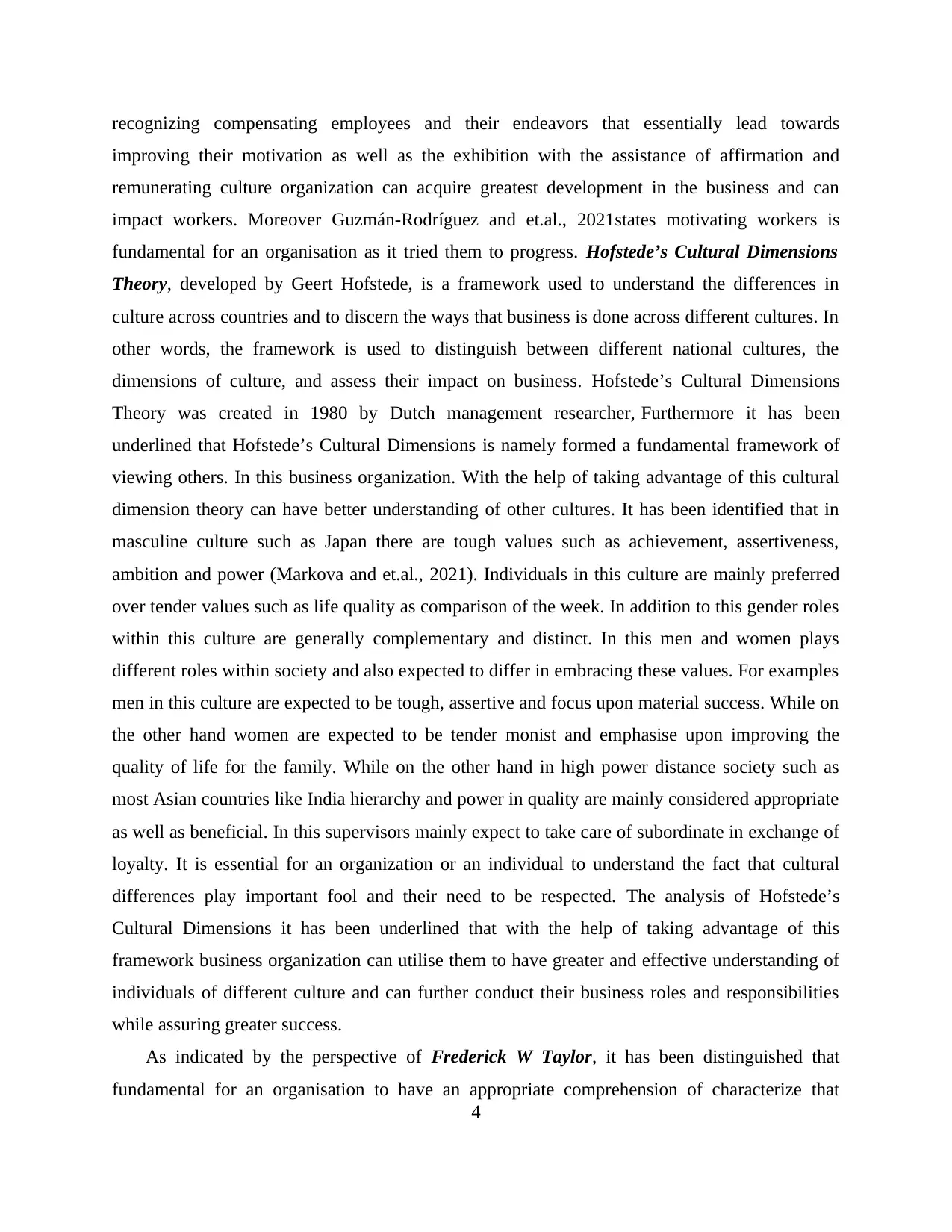
recognizing compensating employees and their endeavors that essentially lead towards
improving their motivation as well as the exhibition with the assistance of affirmation and
remunerating culture organization can acquire greatest development in the business and can
impact workers. Moreover Guzmán-Rodríguez and et.al., 2021states motivating workers is
fundamental for an organisation as it tried them to progress. Hofstede’s Cultural Dimensions
Theory, developed by Geert Hofstede, is a framework used to understand the differences in
culture across countries and to discern the ways that business is done across different cultures. In
other words, the framework is used to distinguish between different national cultures, the
dimensions of culture, and assess their impact on business. Hofstede’s Cultural Dimensions
Theory was created in 1980 by Dutch management researcher, Furthermore it has been
underlined that Hofstede’s Cultural Dimensions is namely formed a fundamental framework of
viewing others. In this business organization. With the help of taking advantage of this cultural
dimension theory can have better understanding of other cultures. It has been identified that in
masculine culture such as Japan there are tough values such as achievement, assertiveness,
ambition and power (Markova and et.al., 2021). Individuals in this culture are mainly preferred
over tender values such as life quality as comparison of the week. In addition to this gender roles
within this culture are generally complementary and distinct. In this men and women plays
different roles within society and also expected to differ in embracing these values. For examples
men in this culture are expected to be tough, assertive and focus upon material success. While on
the other hand women are expected to be tender monist and emphasise upon improving the
quality of life for the family. While on the other hand in high power distance society such as
most Asian countries like India hierarchy and power in quality are mainly considered appropriate
as well as beneficial. In this supervisors mainly expect to take care of subordinate in exchange of
loyalty. It is essential for an organization or an individual to understand the fact that cultural
differences play important fool and their need to be respected. The analysis of Hofstede’s
Cultural Dimensions it has been underlined that with the help of taking advantage of this
framework business organization can utilise them to have greater and effective understanding of
individuals of different culture and can further conduct their business roles and responsibilities
while assuring greater success.
As indicated by the perspective of Frederick W Taylor, it has been distinguished that
fundamental for an organisation to have an appropriate comprehension of characterize that
4
improving their motivation as well as the exhibition with the assistance of affirmation and
remunerating culture organization can acquire greatest development in the business and can
impact workers. Moreover Guzmán-Rodríguez and et.al., 2021states motivating workers is
fundamental for an organisation as it tried them to progress. Hofstede’s Cultural Dimensions
Theory, developed by Geert Hofstede, is a framework used to understand the differences in
culture across countries and to discern the ways that business is done across different cultures. In
other words, the framework is used to distinguish between different national cultures, the
dimensions of culture, and assess their impact on business. Hofstede’s Cultural Dimensions
Theory was created in 1980 by Dutch management researcher, Furthermore it has been
underlined that Hofstede’s Cultural Dimensions is namely formed a fundamental framework of
viewing others. In this business organization. With the help of taking advantage of this cultural
dimension theory can have better understanding of other cultures. It has been identified that in
masculine culture such as Japan there are tough values such as achievement, assertiveness,
ambition and power (Markova and et.al., 2021). Individuals in this culture are mainly preferred
over tender values such as life quality as comparison of the week. In addition to this gender roles
within this culture are generally complementary and distinct. In this men and women plays
different roles within society and also expected to differ in embracing these values. For examples
men in this culture are expected to be tough, assertive and focus upon material success. While on
the other hand women are expected to be tender monist and emphasise upon improving the
quality of life for the family. While on the other hand in high power distance society such as
most Asian countries like India hierarchy and power in quality are mainly considered appropriate
as well as beneficial. In this supervisors mainly expect to take care of subordinate in exchange of
loyalty. It is essential for an organization or an individual to understand the fact that cultural
differences play important fool and their need to be respected. The analysis of Hofstede’s
Cultural Dimensions it has been underlined that with the help of taking advantage of this
framework business organization can utilise them to have greater and effective understanding of
individuals of different culture and can further conduct their business roles and responsibilities
while assuring greater success.
As indicated by the perspective of Frederick W Taylor, it has been distinguished that
fundamental for an organisation to have an appropriate comprehension of characterize that
4
Paraphrase This Document
Need a fresh take? Get an instant paraphrase of this document with our AI Paraphraser
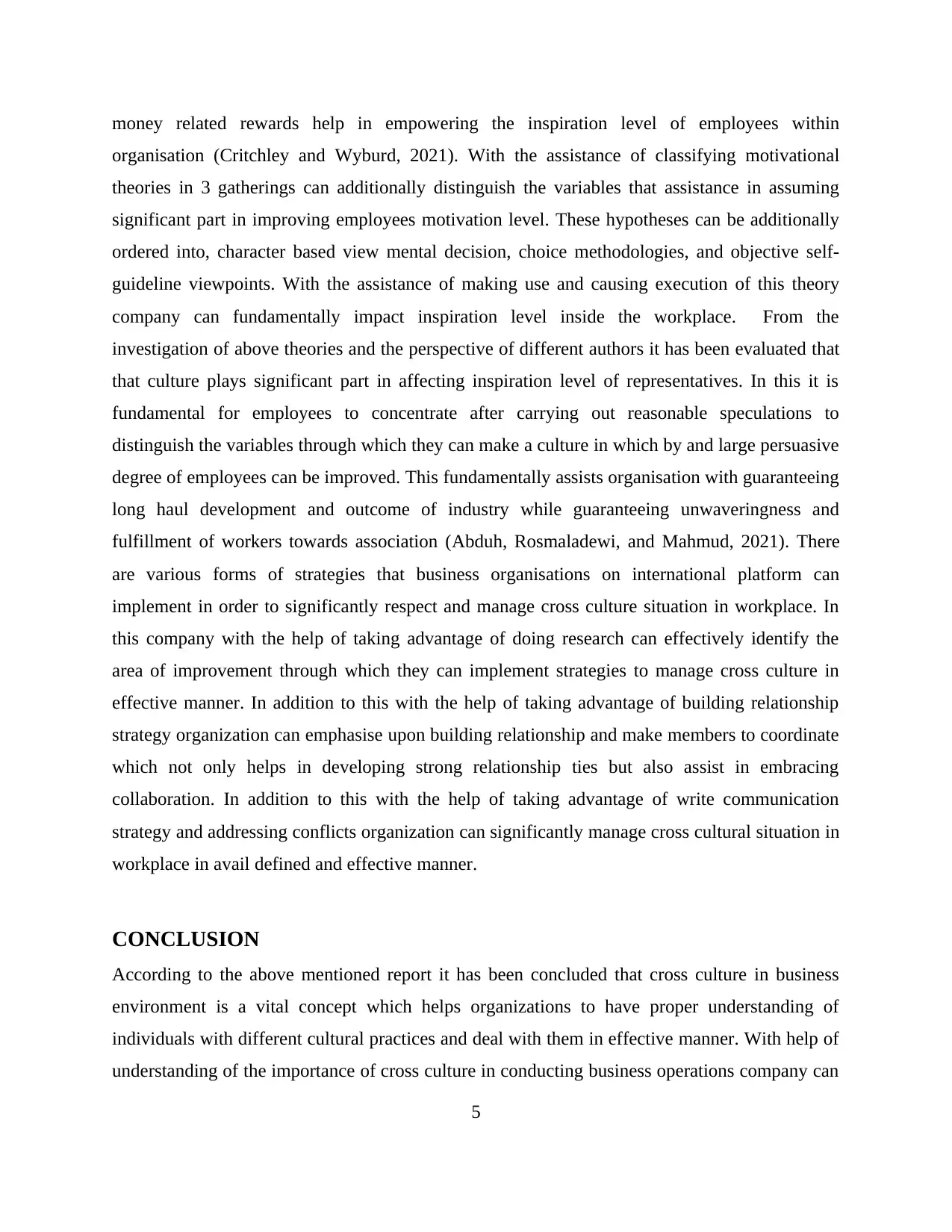
money related rewards help in empowering the inspiration level of employees within
organisation (Critchley and Wyburd, 2021). With the assistance of classifying motivational
theories in 3 gatherings can additionally distinguish the variables that assistance in assuming
significant part in improving employees motivation level. These hypotheses can be additionally
ordered into, character based view mental decision, choice methodologies, and objective self-
guideline viewpoints. With the assistance of making use and causing execution of this theory
company can fundamentally impact inspiration level inside the workplace. From the
investigation of above theories and the perspective of different authors it has been evaluated that
that culture plays significant part in affecting inspiration level of representatives. In this it is
fundamental for employees to concentrate after carrying out reasonable speculations to
distinguish the variables through which they can make a culture in which by and large persuasive
degree of employees can be improved. This fundamentally assists organisation with guaranteeing
long haul development and outcome of industry while guaranteeing unwaveringness and
fulfillment of workers towards association (Abduh, Rosmaladewi, and Mahmud, 2021). There
are various forms of strategies that business organisations on international platform can
implement in order to significantly respect and manage cross culture situation in workplace. In
this company with the help of taking advantage of doing research can effectively identify the
area of improvement through which they can implement strategies to manage cross culture in
effective manner. In addition to this with the help of taking advantage of building relationship
strategy organization can emphasise upon building relationship and make members to coordinate
which not only helps in developing strong relationship ties but also assist in embracing
collaboration. In addition to this with the help of taking advantage of write communication
strategy and addressing conflicts organization can significantly manage cross cultural situation in
workplace in avail defined and effective manner.
CONCLUSION
According to the above mentioned report it has been concluded that cross culture in business
environment is a vital concept which helps organizations to have proper understanding of
individuals with different cultural practices and deal with them in effective manner. With help of
understanding of the importance of cross culture in conducting business operations company can
5
organisation (Critchley and Wyburd, 2021). With the assistance of classifying motivational
theories in 3 gatherings can additionally distinguish the variables that assistance in assuming
significant part in improving employees motivation level. These hypotheses can be additionally
ordered into, character based view mental decision, choice methodologies, and objective self-
guideline viewpoints. With the assistance of making use and causing execution of this theory
company can fundamentally impact inspiration level inside the workplace. From the
investigation of above theories and the perspective of different authors it has been evaluated that
that culture plays significant part in affecting inspiration level of representatives. In this it is
fundamental for employees to concentrate after carrying out reasonable speculations to
distinguish the variables through which they can make a culture in which by and large persuasive
degree of employees can be improved. This fundamentally assists organisation with guaranteeing
long haul development and outcome of industry while guaranteeing unwaveringness and
fulfillment of workers towards association (Abduh, Rosmaladewi, and Mahmud, 2021). There
are various forms of strategies that business organisations on international platform can
implement in order to significantly respect and manage cross culture situation in workplace. In
this company with the help of taking advantage of doing research can effectively identify the
area of improvement through which they can implement strategies to manage cross culture in
effective manner. In addition to this with the help of taking advantage of building relationship
strategy organization can emphasise upon building relationship and make members to coordinate
which not only helps in developing strong relationship ties but also assist in embracing
collaboration. In addition to this with the help of taking advantage of write communication
strategy and addressing conflicts organization can significantly manage cross cultural situation in
workplace in avail defined and effective manner.
CONCLUSION
According to the above mentioned report it has been concluded that cross culture in business
environment is a vital concept which helps organizations to have proper understanding of
individuals with different cultural practices and deal with them in effective manner. With help of
understanding of the importance of cross culture in conducting business operations company can
5
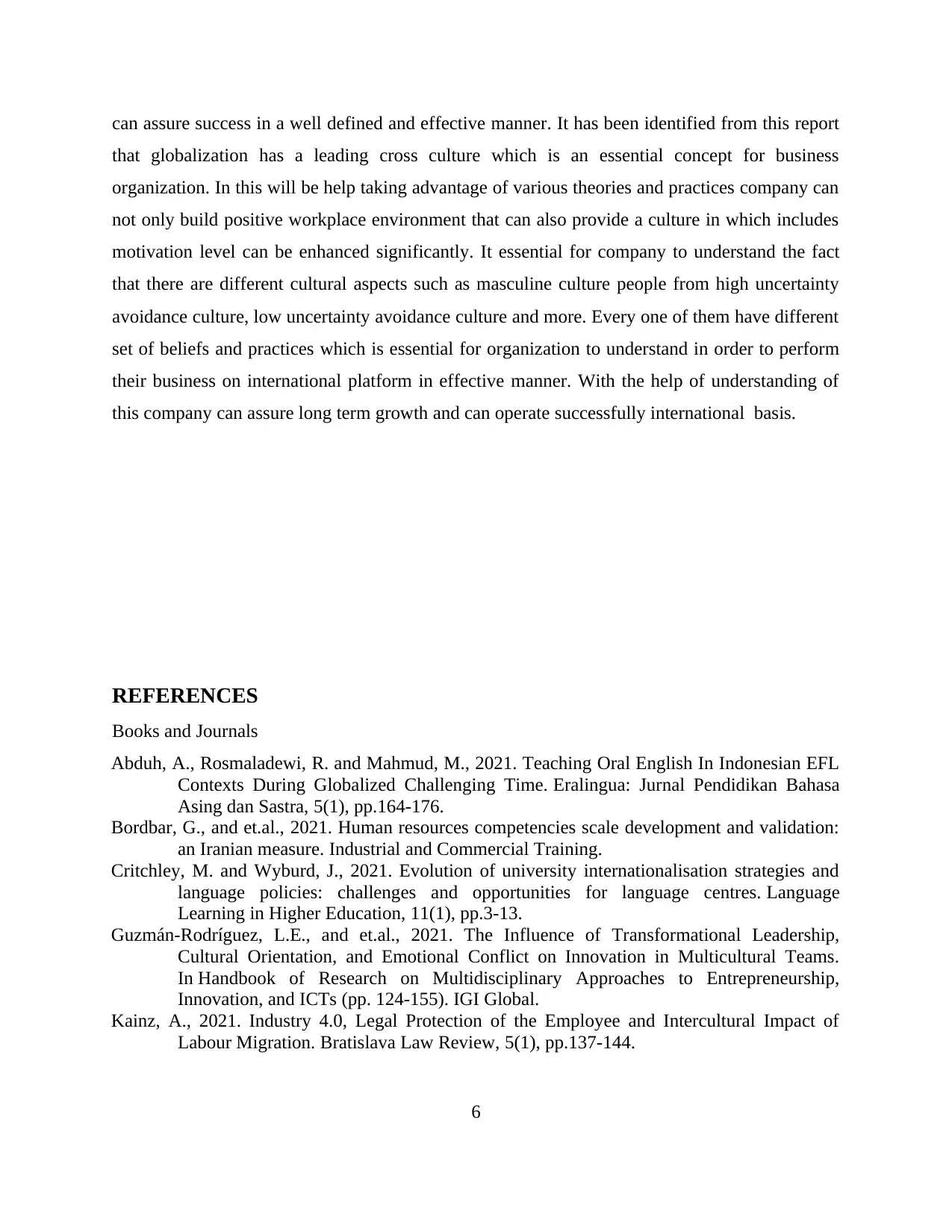
can assure success in a well defined and effective manner. It has been identified from this report
that globalization has a leading cross culture which is an essential concept for business
organization. In this will be help taking advantage of various theories and practices company can
not only build positive workplace environment that can also provide a culture in which includes
motivation level can be enhanced significantly. It essential for company to understand the fact
that there are different cultural aspects such as masculine culture people from high uncertainty
avoidance culture, low uncertainty avoidance culture and more. Every one of them have different
set of beliefs and practices which is essential for organization to understand in order to perform
their business on international platform in effective manner. With the help of understanding of
this company can assure long term growth and can operate successfully international basis.
REFERENCES
Books and Journals
Abduh, A., Rosmaladewi, R. and Mahmud, M., 2021. Teaching Oral English In Indonesian EFL
Contexts During Globalized Challenging Time. Eralingua: Jurnal Pendidikan Bahasa
Asing dan Sastra, 5(1), pp.164-176.
Bordbar, G., and et.al., 2021. Human resources competencies scale development and validation:
an Iranian measure. Industrial and Commercial Training.
Critchley, M. and Wyburd, J., 2021. Evolution of university internationalisation strategies and
language policies: challenges and opportunities for language centres. Language
Learning in Higher Education, 11(1), pp.3-13.
Guzmán-Rodríguez, L.E., and et.al., 2021. The Influence of Transformational Leadership,
Cultural Orientation, and Emotional Conflict on Innovation in Multicultural Teams.
In Handbook of Research on Multidisciplinary Approaches to Entrepreneurship,
Innovation, and ICTs (pp. 124-155). IGI Global.
Kainz, A., 2021. Industry 4.0, Legal Protection of the Employee and Intercultural Impact of
Labour Migration. Bratislava Law Review, 5(1), pp.137-144.
6
that globalization has a leading cross culture which is an essential concept for business
organization. In this will be help taking advantage of various theories and practices company can
not only build positive workplace environment that can also provide a culture in which includes
motivation level can be enhanced significantly. It essential for company to understand the fact
that there are different cultural aspects such as masculine culture people from high uncertainty
avoidance culture, low uncertainty avoidance culture and more. Every one of them have different
set of beliefs and practices which is essential for organization to understand in order to perform
their business on international platform in effective manner. With the help of understanding of
this company can assure long term growth and can operate successfully international basis.
REFERENCES
Books and Journals
Abduh, A., Rosmaladewi, R. and Mahmud, M., 2021. Teaching Oral English In Indonesian EFL
Contexts During Globalized Challenging Time. Eralingua: Jurnal Pendidikan Bahasa
Asing dan Sastra, 5(1), pp.164-176.
Bordbar, G., and et.al., 2021. Human resources competencies scale development and validation:
an Iranian measure. Industrial and Commercial Training.
Critchley, M. and Wyburd, J., 2021. Evolution of university internationalisation strategies and
language policies: challenges and opportunities for language centres. Language
Learning in Higher Education, 11(1), pp.3-13.
Guzmán-Rodríguez, L.E., and et.al., 2021. The Influence of Transformational Leadership,
Cultural Orientation, and Emotional Conflict on Innovation in Multicultural Teams.
In Handbook of Research on Multidisciplinary Approaches to Entrepreneurship,
Innovation, and ICTs (pp. 124-155). IGI Global.
Kainz, A., 2021. Industry 4.0, Legal Protection of the Employee and Intercultural Impact of
Labour Migration. Bratislava Law Review, 5(1), pp.137-144.
6
⊘ This is a preview!⊘
Do you want full access?
Subscribe today to unlock all pages.

Trusted by 1+ million students worldwide
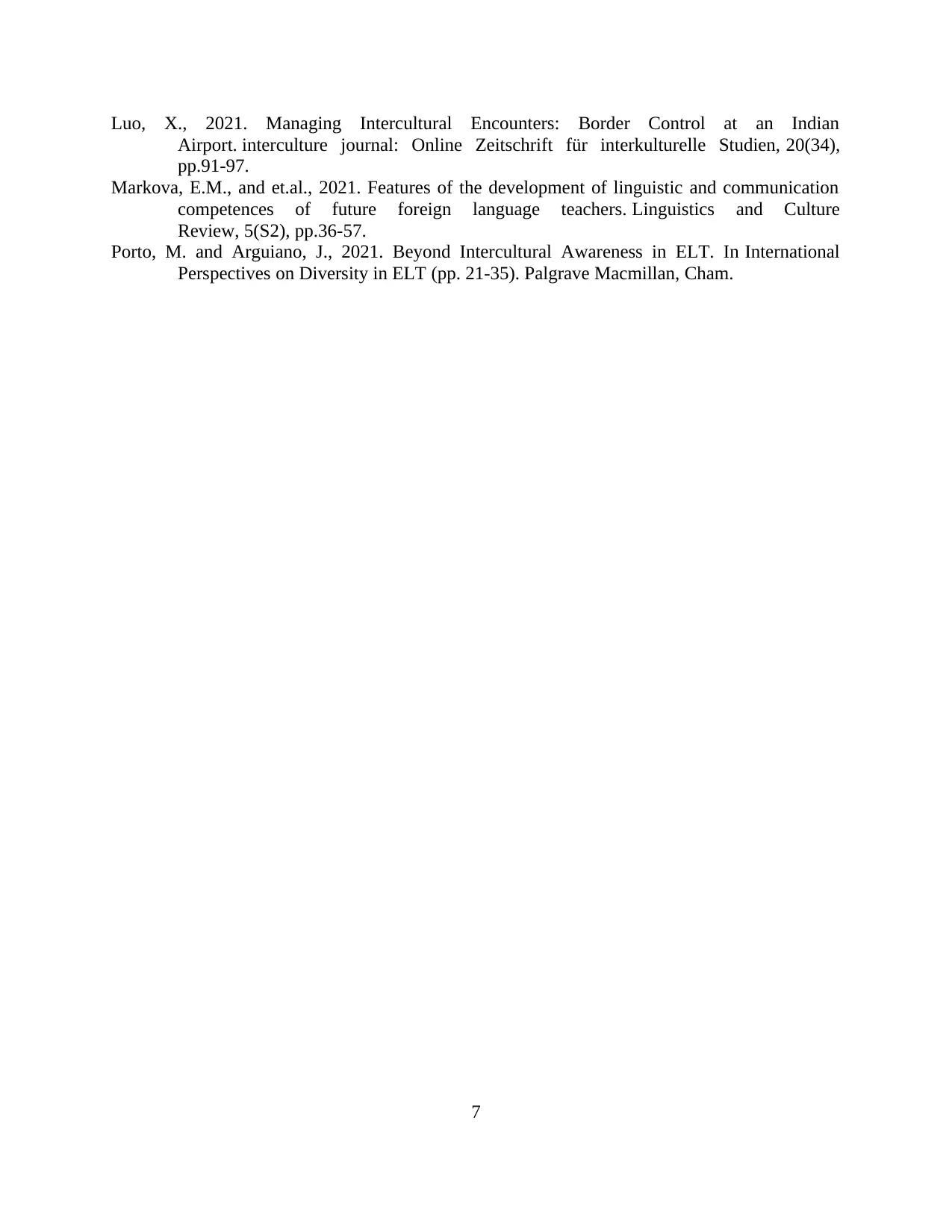
Luo, X., 2021. Managing Intercultural Encounters: Border Control at an Indian
Airport. interculture journal: Online Zeitschrift für interkulturelle Studien, 20(34),
pp.91-97.
Markova, E.M., and et.al., 2021. Features of the development of linguistic and communication
competences of future foreign language teachers. Linguistics and Culture
Review, 5(S2), pp.36-57.
Porto, M. and Arguiano, J., 2021. Beyond Intercultural Awareness in ELT. In International
Perspectives on Diversity in ELT (pp. 21-35). Palgrave Macmillan, Cham.
7
Airport. interculture journal: Online Zeitschrift für interkulturelle Studien, 20(34),
pp.91-97.
Markova, E.M., and et.al., 2021. Features of the development of linguistic and communication
competences of future foreign language teachers. Linguistics and Culture
Review, 5(S2), pp.36-57.
Porto, M. and Arguiano, J., 2021. Beyond Intercultural Awareness in ELT. In International
Perspectives on Diversity in ELT (pp. 21-35). Palgrave Macmillan, Cham.
7
1 out of 7
Related Documents
Your All-in-One AI-Powered Toolkit for Academic Success.
+13062052269
info@desklib.com
Available 24*7 on WhatsApp / Email
![[object Object]](/_next/static/media/star-bottom.7253800d.svg)
Unlock your academic potential
Copyright © 2020–2025 A2Z Services. All Rights Reserved. Developed and managed by ZUCOL.




